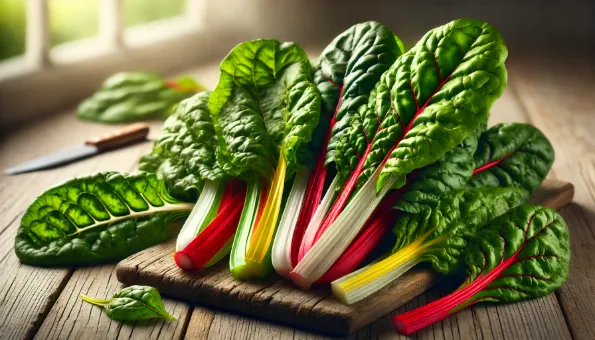Swiss Chard: Leafy Green Powerhouse
Tender leaves and colorful stems—low in calories, rich in vitamin K, A, C, magnesium and nitrates for heart health.

What Is Swiss Chard?
Swiss chard is a **leafy green** with large, dark leaves and **crunchy stems** in white, yellow or red (often sold as **rainbow chard**). It tastes mild and slightly earthy; leaves cook in minutes while stems need a bit longer.
Nutrition Profile
Per 100 g raw: **~19 kcal**, **~3.7 g carbs**, **~1.8 g protein**, **~1.6 g fiber**. Excellent source of **vitamin K**, **vitamin A (beta-carotene)** and **vitamin C**; provides **magnesium, potassium, iron** and natural **dietary nitrates**.
Health Benefits
- **Heart & blood pressure:** natural **nitrates** may support healthy circulation.
- **Bone health:** very high **vitamin K** plus magnesium.
- **Antioxidants:** beta-carotene, flavonoids support cell protection.
- **Gut-friendly:** fibers add bulk and satiety.
Possible Downsides
- **Oxalates:** may contribute to kidney stones in susceptible individuals—rotate greens and hydrate.
- **Vitamin K–warfarin interaction:** keep intake **consistent** if on blood thinners.
- **Sodium in canned/chopped products:** check labels; fresh chard is naturally low in sodium.
How to Use
- **Sauté or wilt** leaves with garlic, olive oil and lemon.
- **Steam or braise** stems first (5–8 min), then add leaves (1–3 min).
- Add to **soups, omelets, pastas, grain bowls**.
- Use stems like celery in **stir-fries or pickles**.
Tip
**Separate stems from leaves** and start cooking stems earlier. A squeeze of **acid (lemon/vinegar)** brightens flavor and color.
- 1. Swiss Chard
Swiss chard (blitva) – lisnato povrće sa širokim stabljikama (bijele, žute, crvene 'rainbow'); listovi se kuhaju brzo, stabljike duže; blag, zemljast okus

